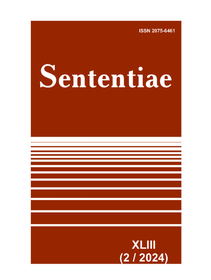Yoga and yogins in the second part of the Bhagavata Purana
DOI:
https://doi.org/10.31649/sent43.02.033Keywords:
bhakti-yoga, Indian philosophy, Vaishnavism, samadhiAbstract
The article examines the yogic problematic, which has not yet become the subject of separate historical-philosophical research. All cases of using in the second part of the Bhagavata Purana words with the base yoga, other related terms and contexts are analyzed. It was found that the defining and dominant version of yoga in the text is its theistic version (bhakti-yoga), which is obviously a modification of the teachings of such philosophical schools as Vedānta, Sāṁkhya, and Yoga. In those cases in which it may be about yoga other than bhakti, polemical motifs appear in the work. Yogins are depicted as able to establish the necessary communication with other, non-human worlds, realizing at the same time the maximum possible for a person, the ultimate (i.e. soteriological) ideal. The Bhāgavata-purāṇa, reports not only about yoga and yogins in earthly conditions, but also about yogic practice in supermundane realities. Yoga, according to the Bhāgavata-purāṇa, appears not as a human creation, but as an eternal cosmic archetype.
References
Sanskrit texts and Translations
Bhagavad Gita. (n.d.). Large-Print Edition. Sanskrit Web. http://www.sanskritweb.net/sansdocs/index.html#GITABIG
Ghosh, Sh. (1999). The Original Yoga as Expounded in Śivasaṃhitā, Gheraṇḍasaṃhitā and Patañjala Yogasūtra. Delhi: Munshiram Manoharlal.
Kali, D. (2011). Śvetāśvataropaniṣad. The Knowledge That Liberates. Translation and Commentary. Lake Worth: Nicolas Hays.
Rau, S. S. (1928). Srimad Bhagavatam Translated into Easy English Prose. Embodying the Inter-pretations of the Three Leading School of Thoughts (Advaita, Visistadvaita and Dvaita) (Vol. I, Skandhas 1-7). Tirupati: Sri Vyasa Press.
Sanātana Goswāmī. (2020). Hari-bhakti-vilāsa. Wisdom Library. https://www.wisdomlib.org/hinduism/book/hari-bhakti-vilasa-sanskrit-text/d/doc493477.html
Sharma, R. P. (Ed.). (2005). Śrīmad-Bhāgavata-Purāṇam of Mahaṛsi of Vedavyāsa. Skandha II. Tirupati: Tirumala Tirupati Devasthanams.
Shastri, J. L. (Ed.). (1992). The Bhāgavata Purāṇa. Part I. (G. V. Tagare, Trans.). Delhi: Motilal Banarsidass.
Śiva Purāṇa. (2020, November 11). Śiva Purāṇa. Wisdom Library. https://www.wisdomlib.org/hinduism/book/shiva-purana-sanskrit/d/doc377591.html
Skanda Purāṇa. (2021, August 9). Skanda Purāṇa. Wisdom Library. https://www.wisdomlib.org/hinduism/book/skanda-purana-sanskrit/d/doc736813.html
Śrīmad-bhāgavata-purāṇam. (n.d.). Śrīmad-bhāgavata-purāṇam. Sanskrit Web. http://www.sanskritweb.net/sansdocs/index.html#BHAGPUR
Svetasvatara-Upanisad. (n.d.). Svetasvatara-Upanisad. GRETIL (Download from “Sanskrit Doc-umentsˮ). https://gretil.sub.uni-goettingen.de/gretil.html
Secondary Sources
Adluri, S. (2017). Yoga in the Viṣṇu Purāṇa, Journal of Indian Philosophy, 45, 381-402. https://doi.org/10.1007/s10781-017-9313-7
Agnihotri, B. S. (1963). The Consepts of Yoga in the Bhāgavata Purāṇa. Journal of the Bihar (and Orissa) Research Society, 49, 178-185.
Bhaṭṭācārya, S. (1960). The Philosophy of the Śrīmad-Bhāgavata. Vol. 1. Metaphysics. Santiniketan: Visva-Bharari.
Bhaṭṭācārya, S. (1962). The Philosophy of the Śrīmad-Bhāgavata. Vol. 2. Religion. Santiniketan: Visva-Bharari.
Broo, M. (2013). Heresy and Heretics in the Bhāgavata Purāṇa. In R. M. Gupta & K. R. Valpey (Eds.), The Bhāgavata Purāṇa: Sacred Text and Living Tradition (pp. 145-161). New York: Columbia University Press.
Das, Bh. (1938). A Concordance-Dictionary to the Yoga-Sūtra of Patañjali and the Bhāshya of Vyāsa. Benares: Kāshī Vidyā-Pītha.
Divanji, P. C. (1962). Bhāgavadgītā and Bhāgavata Purāṇa as Models for the Yogavāsiṣṭha. Journal of the Asiatic Society of Bombay, 34-35, 44-58.
Edelman, J. B. (2013). Dialogues on Natural Theology The Bhāgavata Purāṇa’s Cosmology as Religious Practice. In R. M. Gupta & K. R. Valpey (Eds.), The Bhāgavata Purāṇa: Sacred Text and Living Tradition (pp. 48-62). New York: Columbia University Press.
Gupta, R. M., & Valpey, K. R. (Eds.). (2013). The Bhāgavata Purāṇa: Sacred Text and Living Tradition. New York: Columbia University Press.
Jarow, R. (2003). Tales for the Dying: The Death Narrative of the Bhāgavata-Purāṇa. Albany: State University of New York.
Larson, G. J., & Bhattacharya, R. S. (Eds.). (1987). Encyclopedia of Indian Philosophies. Vol. IV. Sāṃkhya: A Dualist Tradition in Indian Tradition. Delhi: Motilal Banarsidass. https://doi.org/10.1515/9781400853533
Larson, G. J., & Bhattacharya, R. S. (Eds.). (2011). Encyclopedia of Indian Philosophies. Vol. XII. Yoga: India’s Philosophy of Meditation. Delhi: Motilal Banarsidass.
Mallinson, J., & Singleton, M. (Eds.). (2017). Roots of Yoga. London: Penguin Books.
Monier-Williams, M. (1992). English and Sanskrit Dictionary. Delhi: Motilal Banarsidass Pub-lishers.
Monier-Williams, M. (1899). Sanskrit-English Dictionary. Cologne Digital Sanskrit Dictionaries. https://www.sanskrit-lexicon.uni-koeln.de/scans/MWScan/2014/web/webtc/indexcaller.php
Newcombe, S., & O’Brien-Kop, K. (Eds.). (2021). Routledge Handbook of Yoga and Meditation Studies. London & New York, Routledge. https://doi.org/10.4324/9781351050753
New Testament. (n.d.). John. Catholic Online. https://www.catholic.org/bible/book.php?id=50
Olivelle, P. (Ed.). (1992). Saṃnyāsa Upaniṣads. Hindu Scriptures on Asceticism and Renunciation. New York & Oxford: Oxford University Press. https://doi.org/10.1093/oso/9780195070453.001.0001
Olivelle, P. (2011). Ascetics and Brahmins Studies in Ideologies and Institutions. London, New York, & Delhi: Anthem Press. https://doi.org/10.7135/UPO9781843318026
Pai, G. K. (2007). Yoga Doctrines in Mahāpūraṇa-s. Pune: Bhandarkar Oriental Research Institute.
Radhakrishnan, S. (1960). The Brahma Sutra. The Philosophy of Spiritual Life. London: George Allen & Unwin.
Ruff, J. C. (2002). History, Text, and Context of the Yoga Upaniṣads. A Dissertation submitted in partial satisfaction of the requirements for the degree of Doctor of Philosophy in Religious Study. Santa Barbara: University of California.
Scherbatskoj, F. I. (1995). Theory of Knowledge and Logic According to the Teachings of the Later Buddhists (Part 2). [In Russian]. Saint-Petersburg: Acta-Press.
Sheridan, Daniel P. (1986). The Advaitic Theism of•the Bhāgavata Purāṇa. Delhi: Motilal Banarsidass.
Sivananda, Sri Swami. (n.d.). Yoga Vedanta Dictionary. Durban: Divine Life Society of South Africa.
Zavhorodnii, Yu. (2022). Yoga and Yogins in the Bhāgavata Purāṇa (the first part). [In Ukrainian]. Multiversum, 2(1), 58-86. https://doi.org/10.35423/2078-8142.2022.2.1.3
Downloads
-
PDF (Українська)
Downloads: 148
Published
How to Cite
Issue
Section
License

This work is licensed under a Creative Commons Attribution 4.0 International License.
- Authors who publish with this journal agree to the following terms:
- Authors retain copyright and grant the journal right of first publication.
- Authors are able to enter into separate, additional contractual arrangements for the non-exclusive distribution of the journal's published version of the work (e.g., post it to an institutional repository or publish it in a book), with an acknowledgment of its initial publication in this journal.
- Authors are permitted and encouraged to post their work online (e.g., in institutional repositories or on their website) prior to and during the submission process, as it can lead to productive exchanges, as well as earlier and greater citation of published work.









.jpg)
.png)



